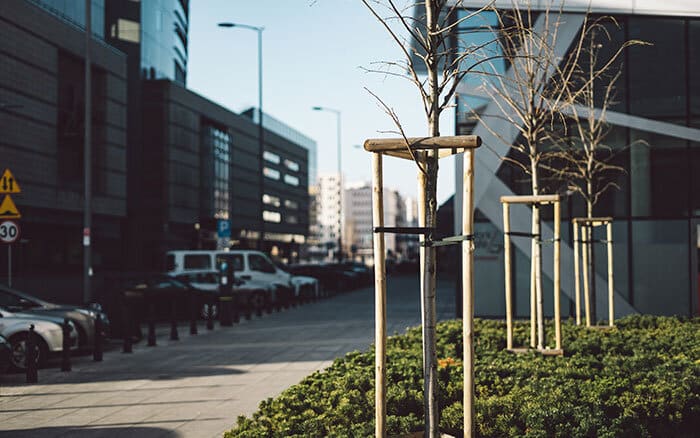Staking trees helps trees to establish and withstand windy conditions in exposed sites. Sometimes, giving support to young trees can be more harmful in the long run because some studies have shown that leaving young trees to sway in the breeze live longer than those that are staked.
The explanation for this is that the tree focuses its energy into growing taller instead of wider which leads to a weaker trunk and less developed roots that anchor it in place.
Whether you stake a new tree or not may depend on how you bought it. Trees with root balls may be bottom heavy and robust enough to support themselves without the need for extra help. On the other hand, bare root trees may benefit from that extra support whilst it establishes.
The stakes can be removed when the tree can stand on its own without moving in the ground. Depending on the type of tree, it can take 2-3 years until this point.

Planting the tree
Dig a hole that’s at least half the size bigger than the pot that the container-grown tree came in, but at the same depth. Digging a square hole encourages the roots to spread rather than staying in the rounded shape and staying close to the tree.
When removing the tree from the container, tease the roots and spread them out when placing the tree into the hole. Gradually add soil, firming down each later to fill gaps and voids effectively.

Tree staking styles
When staking trees, ensure the posts aren’t driven through the roots, instead position them outside the area.
Single staking is most effective when planting bare root trees, and it’s best to position the support before planting to ensure it is away from the roots. Choose where to place it depending on the direction of the wind. Set the stake on the side of oncoming wind so the tree is blown in the direction away from it.
The support should measure to be around a third of the height of the tree.
Double staking involves two posts being positioned around the tree, again outside the root ball. These are then held to the tree using ties. Perfect for particularly windy sites.
The double stake and crossbar technique is used on pot-grown plants and involves a wooden bar supporting the tree between the two circular supports on either side of the tree. To protect the tree, a rubber cushion is attached between the tree and the wooden bar, then the rubber belt is nailed to the bar to keep it secure.
Multiple posts can be positioned an equal distance around the trunk, attached using tree ties, with many different types available.
When growing trees on a slope, angled stakes are a practical solution. Insert the stakes at a 45-degree angle, again leaning towards the prevailing wind.

Tree ties
There are many types of tree ties available. One type is the specialist tie that is like a belt buckle, this means it can be loosened as the tree grows. The belts and spacers, which can be made of rubber that stops the tree and stake from rubbing against each other and causing damage or weakness.
A DIY method is to use an old pair of tights because they won’t cause friction damage and are stretchy so won’t limit growth.
It’s ideal to check stakes and ties every year to ensure the tree ties aren’t too tight which can cause damage to the stems. Any damaged, broken, or frayed stems can be replaced and retied.


Leave A Comment